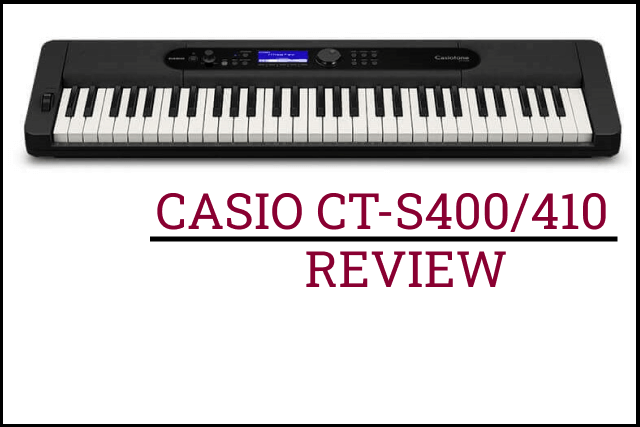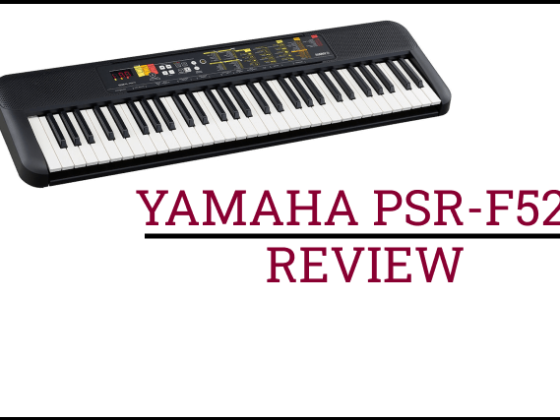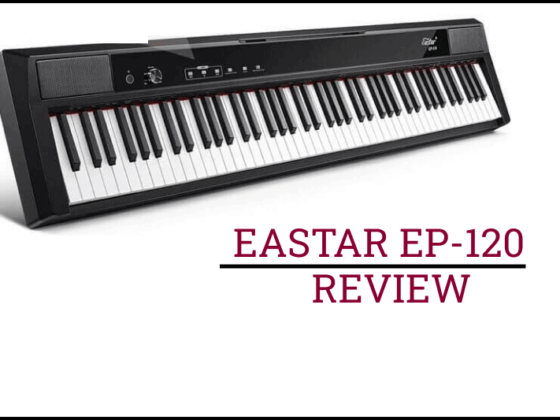The CT-S series, which bears the same name as the company’s initial keyboard series, is Casio’s more recent entry into the market. While the CT-S line’s first three models gradually improved on the same body by adding new functions and tones with each model, Casio CT-S400 has undergone a total overhaul, inside and outside, for the good.
While keeping the core features of the series, it either replaces or enhances features that users had been complaining about in the previous Casiotones.
But, is it worth your money? Who is this keyboard best for? Are there better alternatives?
I’ll be trying to answer these questions in this in-depth review.
Pros
- Touch-sensitive keys with better key action than its predecessors
- Lightweight and portable design
- User-friendly interface
- New AiX Sound Engine for rich and realistic tones
- 600 built-in sounds, 200 rhythms, and 160 songs
- Advanced connectivity options
- 6-track midi recorder
- Good variety of functions
Cons
- No color options
- Lack of felt strip at the top of the keys
Design
Like Casio’s other entry-level keyboards, Casio CT-S400 boasts impressive portability features.
First, it has a sleek and compact design, with a weight of only 4.5 kilograms (9.9 lbs), making it super easy to transport and store. It’s worth mentioning that it’s slightly heavier than the Casio CT-S200 and CT-S300, both weighing 3.3 kilograms (7.3 lbs). Still, it’s a very lightweight keyboard that any adult or child can effortlessly carry.
By the way, if you want to compare this keyboard with other Casiotones, you can check out these posts:
Additionally, the CT-S400 has a battery-powered option, making it easy to take your music on the go.
The Casio CT-S400 is designed with convenience in mind, featuring pins for attaching a guitar strap instead of the built-in carry handle that we saw in the previous models. This allows for easy transportation of the keyboard, as it can be carried on the shoulder like a guitar.
While the carry handle was incredibly functional in the previous models, I love this replacement with the pins for guitar straps in the CT-S400. It makes carrying the instrument even more effortless and it just looks so cool!
Another highlight of the Casio CT-S400 is its intuitive and user-friendly interface. The earlier Casiotone models didn’t feature a backlit LCD screen, which made functions difficult to navigate in dim light. Casio has taken customer feedback into account and has included a large, bright, and easily readable backlit LCD screen in the CT-S400.
In addition, the buttons below the screen are customizable, meaning you can assign whatever control you want to use most often to them. This is an incredible time saver and makes navigating and accessing various functions on the keyboard much more intuitive compared to the earlier Casiotones.
Casio CT-S400 comes keyboard only. You can check out this bundle on Amazon that comes with a stand, bench, and a few extra accessories.
Keys
Casio CT-S400 boasts 61 full-size and touch-responsive keys that give a somewhat semi-weighted feeling. The touch sensitivity has 3 levels, which is more than what the CT-S300 has.
Related: 10 Best Cheap 88-Key Keyboards & Digital Pianos in 2024
The most significant upgrade in the Casio CT-S400 is the key action. Compared to the Casio CT-S100, 200, and 300, the CT-400 features a remarkably better quality key action, which is also reflected in the price. If you ask my opinion, I think a better key action is definitely worth investing more in, especially if you’re serious about learning the piano.
The enhanced key action in the CT-S400 allows you to better control the dynamics and add more expression to your playing. The keys sound quieter and feel close to that of an acoustic piano. In addition, the keytops have a subtler texture that resembles the appearance of genuine ebony and ivory.
As an entry-level keyboard, Casio CT-S400 has impressed me with its premium quality key action.
Sounds
Another selling point of the Casio CT-S400 is the new AiX Sound Engine it features. The AiX engine allows the keyboard to produce a more vivid, high-resolution, and realistic sound. The earlier Casio CT-S100, 200, and 300 used the older AHL sound engine, which didn’t deliver the most impressive tone quality.
When it comes to the sound library, the CT-S400 boasts an expanded sound and rhythm collection compared to previous Casiotone models. With 600 built-in tones, 200 rhythms, and 160 songs, Casio CT-S400 almost doubles its sound library from previous Casiotones. Despite featuring more sounds, the sound quality is significantly better in the CT-S400.
While the tones except for the pianos, electric pianos, and strings didn’t sound quite playable in the earlier models, most of the tones in Casio CT-S400 sound exceptional and don’t require any adjustment. Overall, the sounds are more sophisticated and have more depth mainly because of the newer sound engine.
This keyboard features 48 notes of polyphony. It won’t be enough for an experienced player, but for a beginner, it will get the job done. It should also be noted that the polyphony in the CT-S400 is higher than in the earlier models.
You will also find reverb, chorus and EQ effects that can be used to tweak and experiment with the tones.
Speakers
Casio CT-S400 is equipped with a high-quality speaker system that is designed to deliver a powerful sound despite the size of the keyboard. There are 2 speakers located on the sides of the keyboard (2.5W + 2.5W), which is enough to fill an average-sized room with high enough volume.
This keyboard also features Horizontal Bass Reflex technology that boosts the low ends, missing in the previous models.
Connectivity
Casiotone CT-S400 offers a wide range of connectivity options.
What’s new in the CT-S400 is the USB to-device port that allows you to connect a USB storage device to the instrument. With this port, you can utilize the WU-BT10, Casio’s wireless MIDI & Audio adapter that connects the music apps to the keyboard through Bluetooth without requiring any wire connection.
The WU-BT10 adapter also allows you to stream audio from your devices to the amazing speaker system on the keyboard. This adapter is sold separately, but it unlocks incredible functionality that in my opinion makes it worth the investment.
Other than that, this keyboard is equipped with all the connectivity options that are available in other Casiotones such as a pedal input, stereo audio input, headphone output, DC input, and a micro USB port.
Features
Functions
Casiotone CT-S400 is equipped with many functions, some of which include:
- Metronome
- Transposition
- Layer/Split Modes
- Arpeggiator
- Recording
- Pitch Bend Wheel
- Octave Shift
- Auto Harmonize
- Midi Recorder
- Tuning Adjustment
Auto Accompaniment
Casio CT-S400 comes with an auto accompaniment function. What it does is when you play a chord with your left hand and choose your preferred accompanying rhythm, the accompaniment feature automatically creates an accompaniment to support the melody.
With auto accompaniment, musicians can choose from a variety of different styles and patterns, such as rock, pop, jazz, and many others. The accompaniments can also be customized to match the desired tempo, key, and feel, providing a versatile and flexible tool for musicians.
The auto accompaniment function is a great tool for helping musicians enhance their performance, and is a great feature for anyone looking to improve their skills.
Chordana Play App
Casio CT-S400 can work with the Casio Chordana Play app, enabling users to download MIDI files and access 50 in-app example songs. Beginners can benefit from learning their favorite tunes with this function, which also makes playing more enjoyable.
User Registration
From different tones to rhythms, Casio CT-S400 allows you to save up to 32 user registrations. This feature can be especially useful for musicians who frequently switch between different sound and rhythm settings, as it provides a convenient and efficient way to recall their preferred settings without having to make manual adjustments each time.
One Touch Preset
A classic feature found in most Casiotones, One Touch Preset selects the best tone and rhythm setting for the accompaniment you have chosen. The presets can be selected with the touch of a button, providing an easy way to switch between different settings without having to make manual adjustments.
Casio CT-S400 VS Casio CT-S500
Casio CT-S500 essentially builds on what Casio CT-S400 already has, turning it into more of an arranger keyboard.
The CT-S500 adds 200 more tones and 43 more rhythms to Casio CT-S400’s library and increases the polyphony to 64 notes. In addition, the CT-S500 features a sampler that allows you to create your own sounds using your smart device. However, it cuts down the built-in songs to only one and supports the Casio Music Space app instead of the Chordana Play App.
Both Casio CT-S400 and CT-S500 are equipped with Casio’s newer AiX Sound Engine, which means the sound quality you get from the two is identical.
What truly distinguishes the Casio CT-S500 from the CT-S400 is the arranger features it has. In addition to the reverb, chorus, EQ, and delay effects, Casio CT-S500 features 100 types of DSP effects that you can play with using the 3 control knobs and enhance your performance.
You also get additional connectivity of line output and an expression pedal input with the CT-S500, which is something to consider if you want to use the keyboard for recording sessions or live performances.
Overall, Casio CT-S500 is a more feature-rich keyboard than CT-S400 with many arranger functions that allow for creative and professional music making.
Casio CT-S400 VS Casio CT-S300
While both Casio CT-S400 and Casio CT-S300 are great entry-level options, the CT-S400 is a more advanced keyboard with superior key action, sound, and more features.
Casio CT-S300 is among the budget Casiotones, so it features a less realistic and quality key action compared to the CT-S400. The key action in Casio CT-S400 feels much more premium and real-like.
Another difference can be seen in the sound quality. Casio CT-S300 lacks the AiX Sound Engine the CT-S400 has, which makes a remarkable sound difference between the two in terms of richness, realism, and expressiveness.
In addition, Casio CT-S400 features significantly more tones, rhythms, and songs than the CT-S300 as well as a better interface with a more sophisticated LCD screen and menu navigation.
While you lose the Dance Music Mode in the Casio CT-S400, you gain wireless MIDI & Audio connectivity, which I’d prefer. However, keep in mind that you will need this Bluetooth adaptor to utilize this function and that it’s an additional purchase.
Casio CT-S400 VS Casio CT-S1
Both Casio CT-S400 and CT-S1 are among Casio’s latest releases and stand out from earlier Casiotones with a number of features.
First, both feature the same key action that is realistic and high quality as well as the AiX Sound Engine. Both keyboards are also identical in terms of their portability, having almost the same dimensions and weight as well as guitar strap pins for easy carriage. They can both operate on batteries and work with the Bluetooth adaptor for wireless MIDI and Audio connectivity.
Still, there are some differences you should be aware of before making your decision.
Two of them are the backlit LCD screen and user-friendly interface in the CT-S400 that are not available in the CT-S1. In addition, the CT-S400 is equipped with 600 tones and 200 accompaniment rhythms, while the CT-S1 only features 61 tones and no rhythm. It also lacks the pitch bend wheel that is available in the CT-S400.
However, Casio CT-S1 values quality over quantity, resulting in better-sounding voices which were designed exclusively by Casio.
The CT-S1 also features 64 notes of polyphony compared to 48 in the CT-S400, making it a better option for intermediate players.
Finally, the CT-S1 comes in 3 beautiful colors (white, black, and red) whereas the CT-S400 is only available in black.
To sum up, we can say that Casio CT-S400 is better for beginners who need a variety of fun and educational functions to play around with, while the CT-S1 is better suited for more advanced players who don’t need as many tones and rhythms, though they are both fantastic budget keyboards for whatever reason you get them.
Casio CT-S400 VS Casio CT-S410
I asked some stores about the difference between the Casio CT-S400 and CT-S410, and they told me that the CT-S410 offers one additional track recording and that all other features are the same. However, I couldn’t see such a difference when I checked out Casio’s site. I also see that the CT-S410 is sold more to countries outside the U.S., but I still saw some U.S. stores selling it.
Whatever the difference between them, you can be assured that they are essentially the same keyboard with a very insignificant and minor difference, if there is any difference at all.
Conclusion
To sum up, I think Casio CT-S400 is one the best keyboards in the entire Casiotone product line and offers great value for money. Providing more features and functions than its predecessors, it also enhances the key action and sound quality by employing newer technologies while still managing to advance on portability.
Whether you are looking to learn how to play the piano, want to record your own music, or play performances, the Casio CT-S400 is a great choice.
I hope this Casio CT-S400 review has been helpful. Let me know if you have any questions in the comments section below!













